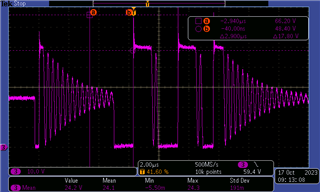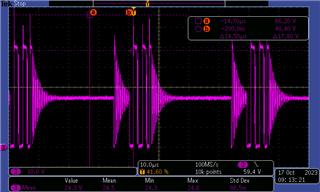Other Parts Discussed in Thread: , LM25183,
I modified LM25184EVM-S12 per correspondence with Youhao so that I could run at 24V in and 24 V out. See below.
Thank you for consider the LM25184. You can modify the output by raising the resistor at the FB pin, but you will have to replace a few more parts:
- C9 on the EVM is just 16V rated. You need to change it to be able to handle your new output.
- D3 is a 13V Zener and it will be damaged if you simply raise the output voltage. Consider to replace it with a 26V Zener.
- C6 and C7 are 25V rated, too close to your 24Vout. Consider to change to 50V rated to get margin.
- D1 is 60V rated. You may consider to change it with a 100V rated diode.
- D2 is 20V rated and it would be damaged by the flyback voltage if Vout is changed to 24V. Suggest to change to a 32V Zener.
I connected 177 ohm, 8W resistor and let it run. Iout was .136A. Vout = 24.1V. I did 3 runs and on each run at approx 20 min into the run, the output voltage stepped up to 25.5 V and .144A. I monitored the SW node TP2 with a scope during the run. Attached are the waveform before the problem and after. The first is before and looks nice and repetitive, and the next 2 are after at different sweep rates. They look like burst mode or something. Can you please tell me why this is happening? The current is very low.







